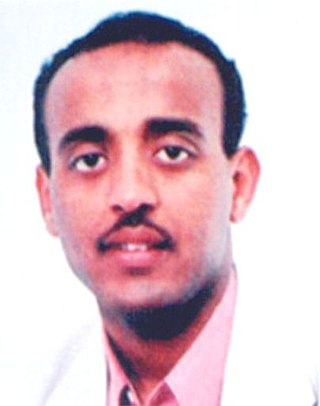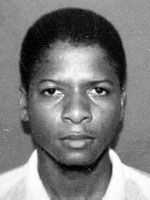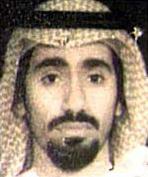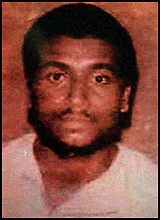
Ramzi Mohammed Abdullah bin al-Shibh is a Yemeni citizen currently being held by the U.S. as an enemy combatant detainee at Guantanamo Bay in Cuba. He is accused of being a "key facilitator for the September 11 attacks" in 2001 in the United States.

Ahmed Ressam, also known as the "Millennium Bomber", is an Algerian al-Qaeda member who lived for a time in Montreal, Quebec, Canada. He received extensive terrorist training in Afghanistan.
Wadih Elias el-Hage is a Lebanese, and naturalized American citizen, who is serving life imprisonment in the United States based on conspiracy charges relating to the 1998 United States embassy bombings.

Walid Muhammad Salih bin Mubarak bin Attash is a Yemeni prisoner held at the United States' Guantanamo Bay detention camp under terrorism-related charges and is suspected of playing a key role in the early stages of the 9/11 attacks. The Office of the Director of National Intelligence has described him as a "scion of a terrorist family". American prosecutors at the Guantanamo military commissions allege that he helped in the preparation of the 1998 East Africa Embassy bombings and the USS Cole bombing and acted as a bodyguard to Osama bin Laden, gaining himself the reputation of an "errand boy". He is formally charged with selecting and helping to train several of the hijackers of the September 11 attacks.

Ahmed Khalfan Ghailani is a Tanzanian conspirator of the al-Qaeda terrorist organization convicted for his role in the bombing of embassies in Kenya and Tanzania. He was indicted in the United States as a participant in the 1998 U.S. embassy bombings. He was on the FBI Most Wanted Terrorists list from its inception in October 2001. In 2004, he was captured and detained by Pakistani forces in a joint operation with the United States, and was held until June 9, 2009, at Guantanamo Bay detention camp; one of 14 Guantanamo detainees who had previously been held at secret locations abroad. According to The Washington Post, Ghailani told military officers he is contrite and claimed to be an exploited victim of al-Qaeda operatives.

Abd al-Rahim Hussein Muhammed Abdu al-Nashiri is a Saudi Arabian citizen alleged to be the mastermind of the bombing of USS Cole and other maritime attacks. He is alleged to have headed al-Qaeda operations in the Persian Gulf and the Gulf states prior to his capture in November 2002 by the CIA's Special Activities Division.

Jamal Ahmad Mohammad Ali Al Badawi aka Jamal Abu Abed Al Rahman Al Badawi was a Yemeni who was indicted as an accomplice for his role in the 2000 USS Cole bombing off the coast of Aden, Yemen, which killed 17 American sailors on 12 October 2000. He was captured in Yemen and sentenced to death on 29 September 2004. Al-Badawi was also indicted on 15 May 2003, by the United States for the USS Cole bombing and the attempted attack on USS The Sullivans. He is thought to have travelled to Saudi Arabia and purchased a small boat and then a truck and trailer to transport it. This boat sank from the weight of the explosives while preparing the USS The Sullivans plot. Al-Badawi is also thought to have leased the safehouses used in these endeavors. Fox News called Al-Badawi a "mastermind" of the Cole bombing.
The Al Farouq training camp, also called Jihad Wel al-Farouq, was a Taliban and Al-Qaeda training camp near Kandahar, Afghanistan. Camp attendees received small-arms training, map-reading, orientation, explosives training, and other training. Nasir al-Bahri reported that the camp was only established following the arrival of Egyptian Islamic Jihad and Egyptian Islamic Group militants who had suitable expertise as to provide training to others.

Khalfan Khamis Mohamed, a Tanzanian national, is one of numerous al-Qaeda suspects who were indicted in 1998, and one of the four who were convicted and sentenced to life without parole in 2001, for their parts in the 1998 United States embassy bombings. Convicted along with Mohamed were Wadih el Hage, Mohammed Saddiq Odeh, and Mohamed Rashed Daoud Al-Owhali.

Jabir Jubran Al Fayfi is a citizen of Saudi Arabia who was held in extrajudicial detention in the United States Guantánamo Bay detention camp, in Cuba on allegations he trained and fought with al-Qaeda and the Taliban in Afghanistan in 2001.
Abdallah Saleh Ali Al Ajmi was a Kuwaiti citizen, who was held in extrajudicial detention in the United States Guantanamo Bay detainment camps, in Cuba. His Guantanamo Internment Serial Number was 220. Joint Task Force Guantanamo counter-terrorism analysts reports indicated that he was born on 2 August 1978, in Almadi, Kuwait.

Mohammed Saddiq Odeh is a Saudi-born al-Qaeda member, sentenced in October 2001 to life imprisonment for his parts in the US embassy bombings in Kenya and Tanzania on August 7, 1998. Odeh was convicted along with three co-conspirators: Mohamed Rashed Daoud Al-Owhali, Khalfan Khamis Mohamed and Wadih el Hage. Another defendant, Ali Mohamed, pleaded guilty the previous year. Another, Mahdouh Salim, was awaiting trial, and three additional defendants were fighting extradition in England.
Fahd Mohammed Ahmed al-Quso, also known as Abu Huthaifah, Abu Huthaifah Al-Yemeni, Abu Al-Bara', Abu Hathayfah Al-Adani, Abu Huthaifah Al-Adani, Fahd Mohammed Ahmed Al-Awlaqi, Huthaifah Al-Yemeni, or Abu Huthaifah Al-Abu Al-Bara, was alleged to be a terrorist by American and Yemeni officials, and on the FBI Most Wanted Terrorists list. He was wanted by the FBI, Interpol, and the United States Department of State, which had offered 5 million dollars to anyone with information about him. He was killed by a US drone strike in Yemen on 6 May 2012.
American counter-terrorism analysts justified the continued extrajudicial detention of many Guantanamo captives because they were suspected of staying in al-Qaeda safe houses, or guest houses—or because names matching theirs, or their "known alias" were found in the suspect houses.
The American intelligence analysts who compiled the justifications for continuing to detain the captives taken in the "war on terror" made dozens of references to al Qaida safe houses, in Karachi, Pakistan.
The Jihad Wahl training camp was an alleged al Qaeda training camp in Afghanistan.

The 1998 United States embassy bombings were attacks that occurred on August 7, 1998. More than 220 people were killed in nearly simultaneous truck bomb explosions in two Capital East African cities, one at the United States Embassy in Dar es Salaam, Tanzania and the other at the United States Embassy in Nairobi, Kenya.
An Egyptian resident of British Columbia, Essam Hafez Mohammed Marzouk arrived in Vancouver, British Columbia, Canada in 1993 as a refugee fleeing persecution in Pakistan. He was one of 14 people subjected to extraordinary rendition by the CIA prior to the 2001 declaration of a war on terror. Marzouk was the contact point for a bin Laden terrorist cell in Canada.

Ali H. Soufan is a Lebanese-American former FBI agent who was involved in a number of high-profile anti-terrorism cases both in the United States and around the world. A 2006 New Yorker article described Soufan as coming closer than anyone to preventing the September 11 attacks and implied that he would have succeeded had the CIA been willing to share information with him. He resigned from the FBI in 2005 after publicly chastising the CIA for not sharing intelligence with him which could have prevented the attacks.











